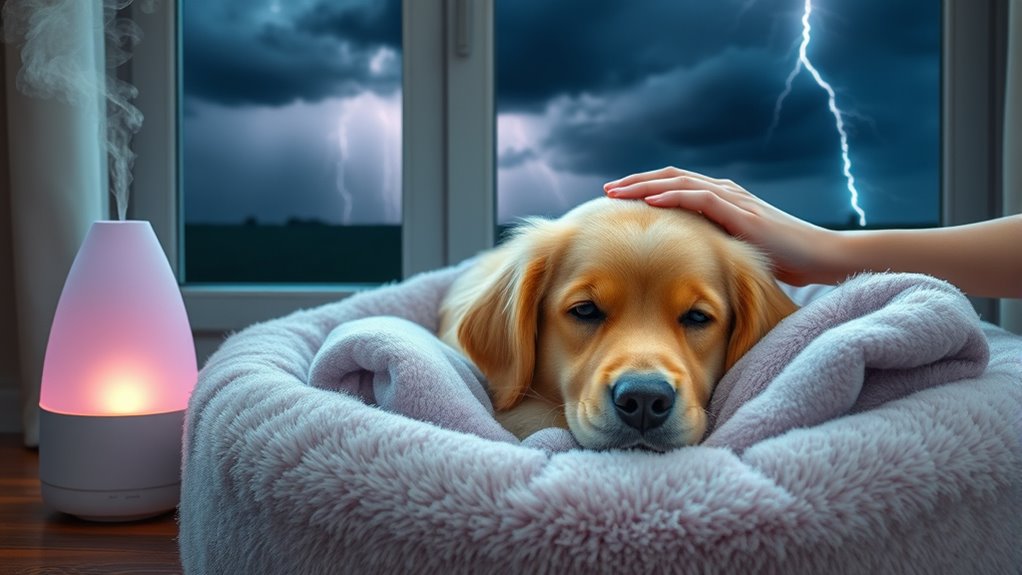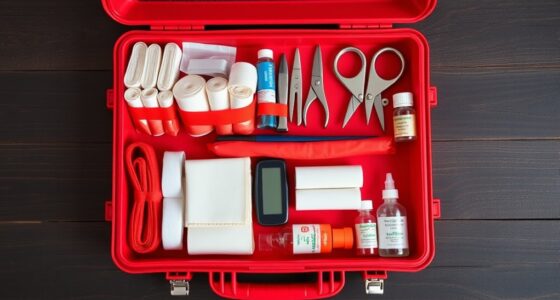During disasters, you can help your pet by creating a safe, familiar space with comforting items and calming scents like lavender. Keep routines consistent to provide reassurance and engage them with toys or puzzles to distract from chaos. Use sound desensitization by gradually exposing them to loud noises at low volumes. Stay calm yourself, as your demeanor greatly influences their anxiety levels. Continually applying these techniques will help your pet feel more secure during stressful times.
Key Takeaways
- Create a designated, comforting retreat with familiar items and calming scents for pets to self-soothe during stress.
- Use gradual sound desensitization with recordings of loud noises to build resilience proactively.
- Maintain consistent routines and engaging activities to provide a sense of normalcy amid chaos.
- Incorporate calming aromas like lavender with diffusers or sprays to help relax pets during emergencies.
- Stay calm and confident, using a gentle tone to reassure pets and reduce their anxiety during disasters.

During disasters, your pets can become anxious and stressed, which can affect their health and well-being. Recognizing this, it’s vital to incorporate effective calming techniques into your disaster preparedness plans. When a disaster strikes, your pet’s usual routines are disrupted, and unfamiliar sights, sounds, and smells can heighten their anxiety. By proactively establishing calming techniques beforehand, you can help soothe their nerves and reduce their stress levels during these challenging times.
One of the most effective calming techniques is creating a safe, comfortable space where your pet can retreat. This area should be familiar and stocked with their favorite blanket or toy. During disaster preparedness, make sure this space is easily accessible and that your pet associates it with comfort, so they’ll instinctively seek it out when overwhelmed. Using items with calming scents, such as lavender or chamomile, can also help relax your pet. Diffusers or sprays designed for pets can be incorporated into your disaster preparedness kit, ensuring these soothing aromas are available when needed.
Sound desensitization is another key technique. Gradually exposing your pet to recordings of loud or alarming noises—like sirens, thunderstorms, or explosions—can help them build resilience over time. During your disaster preparedness routines, set up these recordings at low volume, gradually increasing intensity as your pet becomes more accustomed. This exposure can reduce their fear response when actual disasters occur. Additionally, playing calming music or white noise can mask unsettling sounds and create a more peaceful environment.
Maintaining a sense of routine is vital as well. During disasters, your pet’s daily schedule can become disrupted, which may increase their anxiety. Incorporate consistent feeding, play, and rest times into your disaster preparedness plan. Even if your environment changes, sticking to familiar routines helps provide reassurance. Using puzzle feeders or interactive toys can engage their minds and distract from the chaos, helping them feel more secure. Research shows that a stable routine can significantly reduce pet stress during emergencies.
Finally, your calm demeanor plays a pivotal role. Pets are highly perceptive of your emotions, so staying composed and confident can reassure them during stressful moments. Practice deep breathing, stay patient, and speak softly to help your pet feel safe. Combining these calming techniques with thorough disaster preparedness ensures you’re ready to support your pet’s emotional well-being when it matters most. Preparedness isn’t just about physical safety; it’s also about fostering a sense of security, so your furry friend can navigate disasters with less fear and more confidence.
Frequently Asked Questions
How Can I Recognize Signs of Extreme Stress in My Pet?
You can recognize signs of extreme stress in your pet by observing behavioral changes like excessive barking, hiding, or pacing. Look for pet anxiety signs such as trembling, panting, or loss of appetite. These are clear indicators that your pet is overwhelmed. If you notice these signs, act quickly to comfort your pet and create a calm environment, helping ease their stress during challenging times.
Are There Specific Calming Products Recommended for Pets During Disasters?
During disasters, calming treats and pheromone diffusers are your best allies to soothe your pet’s chaos-induced anxiety. These products work wonders—calming treats provide gentle relief, while pheromone diffusers mimic natural signals that relax your pet instantly. You’ll notice a calmer, more confident pet even amidst turmoil. Don’t wait—use these specific calming tools to help your furry friend feel safe, secure, and loved during life’s most stressful moments.
How Do I Keep My Pet Comfortable in Emergency Shelters?
To keep your pet comfortable in emergency shelters, create a familiar and cozy space with their favorite blanket or toy to promote pet comfort. Maintain a calm demeanor to reduce their anxiety. Guarantee the shelter environment is quiet and away from loud noises. Offer your pet water regularly and keep their routine as normal as possible. Your presence and reassurance can help them feel safer during this stressful time.
Can Training Beforehand Reduce My Pet’s Disaster-Related Anxiety?
Think of pre-disaster training as building a sturdy bridge over turbulent waters. It can substantially reduce your pet’s disaster-related anxiety by preparing them for unpredictable situations. Through consistent anxiety prevention exercises, you help your pet become familiar with new sounds, sights, and routines. This proactive approach makes them more adaptable and less fearful during emergencies, giving both of you peace of mind when disaster strikes.
What Should I Include in a Pet Emergency Kit for Stress Relief?
You should include calming scents like lavender or chamomile and soothing music in your pet emergency kit to help ease stress during disasters. Pack items like a favorite blanket, toys, and treats that provide comfort. Consider a portable diffuser for calming scents and a device for playing calming music. These items can help keep your pet relaxed and secure amid chaos, making stressful situations more manageable for them.
Conclusion
Remember, during disasters, your calmness can be your pet’s anchor. As you prepare a safe space and stick to familiar routines, you might find that your pet’s stress lessens just when you need it most. Sometimes, it’s the smallest actions—like a comforting voice or a favorite toy—that make the biggest difference. In those quiet moments, you might realize that your presence alone is the best comfort, turning chaos into calm for both of you.










